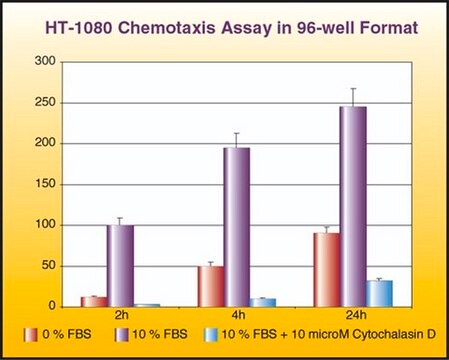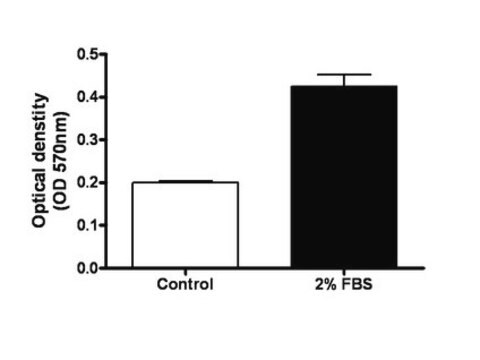ECM530
α Integrin-mediated Cell Adhesion Array Kit, colorimetric
This assay can substitute for FACS analysis & is useful for screening human adherent cells for cell surface integrins or for monitoring in vitro cell differentiation or genetic modification of cells.
Anmeldenzur Ansicht organisationsspezifischer und vertraglich vereinbarter Preise
Alle Fotos(1)
About This Item
UNSPSC-Code:
12352207
eCl@ss:
32161000
NACRES:
NA.84
Empfohlene Produkte
Qualitätsniveau
Speziesreaktivität
human
Hersteller/Markenname
Chemicon®
Methode(n)
cell based assay: suitable
NCBI-Hinterlegungsnummer
Nachweisverfahren
colorimetric
Versandbedingung
wet ice
Angaben zum Gen
human ... ITGA1(3672)
Allgemeine Beschreibung
Introduction
Cell adhesion plays a major role in cellular communication and regulation, and is of fundamental importance in the development and maintenance of tissues. A family of cell surface receptors, the integrins, mediates cell attachment to proteins of the extracellular matrix. Integrins are heterodimer molecules containing an alpha and beta transmembrane glycoprotein subunit that are non-covalently bound together (1-2). Historically, antibodies have been used to determine the integrin profiles of cells by immunoprecipitation, immunofluorescence, immunoblotting, and flow cytometry. These methods are time-consuming, laborious or require sophisticated equipment.
The CHEMICON® Alpha Integrin-Mediated Cell Adhesion Array kit is designed as a cost effective, efficient method for identification of cell surface integrins. The kit format uses 12 x 8-well removable strips in a plate frame for convenience and flexibility in designing assays. The Integrin-Mediated Cell Adhesion Array can be completed within 1-2 hours, providing a rapid, quantitative assay for the characterization of alpha integrin surface expression.
In addition, Chemicon continues to provide numerous migration, invasion, and adhesion products including:
· Beta Integrin-Mediated Cell Adhesion Array (ECM531)
· Alpha/Beta Integrin-Mediated Cell Adhesion Array Combo Kit (ECM532)
· QCM 8μm 96-well Chemotaxis Cell Migration Assay (ECM510)
· QCM 5μm 96-well Chemotaxis Cell Migration Assay (ECM512)
· QCM 3μm 96-well Chemotaxis Cell Migration Assay (ECM515)
· QCM 96-well Cell Invasion Assay (ECM555)
· 24-well Insert Cell Migration and Invasion Assay Systems
· CytoMatrix Cell Adhesion strips (ECM protein coated)
· QuantiMatrix ECM protein ELISA kits
Test Principle
The CHEMICON Alpha Integrin-Mediated Cell Adhesion Array uses mouse monoclonal antibodies generated against human alpha integrins/subunits (alpha1, alpha2, alpha3, alpha4, alpha5, alphaV, and alphavbeta3), that are immobilized onto a goat anti-mouse antibody coated microtiter plate. The plate is then used to capture cells expressing these integrins on their cell surface; goat anti-mouse antibody coated wells are provided as a negative assay control. Each strip (8 wells total) consists of 7 integrin antibody coated wells and one negative control well (see plate layout on page 3). Experimental cells are seeded onto the coated substrate and incubated. Subsequently, unbound cells are washed away, and adherent cells are fixed and stained. Relative cell attachment is determined using absorbance readings.
Additional information about the monoclonals provided in the kit:
* Mouse anti-Alpha 1 [CD49a], clone FB12, (Hu)
* Mouse anti-Alpha 2 [CD49b], clone P1E6, (Hu)
* Mouse anti-Alpha 3 [CD49c], clone P1B5, (Hu)
* Mouse anti-Alpha 4 [CD49d], cloneP1H4. (Hu, Prim)
* Mouse anti-Alpha 5 [CD49e], clone P1D6, (Hu)
* Mouse anti-Alpha V [CD51], clone P3G8, (Hu)
* Mouse anti-Alpha V/Beta 3 [CD51/CD61], clone LM609, (Hu, Bov, Por, Av, Can, Chk, Mky, Rb)
Cell adhesion plays a major role in cellular communication and regulation, and is of fundamental importance in the development and maintenance of tissues. A family of cell surface receptors, the integrins, mediates cell attachment to proteins of the extracellular matrix. Integrins are heterodimer molecules containing an alpha and beta transmembrane glycoprotein subunit that are non-covalently bound together (1-2). Historically, antibodies have been used to determine the integrin profiles of cells by immunoprecipitation, immunofluorescence, immunoblotting, and flow cytometry. These methods are time-consuming, laborious or require sophisticated equipment.
The CHEMICON® Alpha Integrin-Mediated Cell Adhesion Array kit is designed as a cost effective, efficient method for identification of cell surface integrins. The kit format uses 12 x 8-well removable strips in a plate frame for convenience and flexibility in designing assays. The Integrin-Mediated Cell Adhesion Array can be completed within 1-2 hours, providing a rapid, quantitative assay for the characterization of alpha integrin surface expression.
In addition, Chemicon continues to provide numerous migration, invasion, and adhesion products including:
· Beta Integrin-Mediated Cell Adhesion Array (ECM531)
· Alpha/Beta Integrin-Mediated Cell Adhesion Array Combo Kit (ECM532)
· QCM 8μm 96-well Chemotaxis Cell Migration Assay (ECM510)
· QCM 5μm 96-well Chemotaxis Cell Migration Assay (ECM512)
· QCM 3μm 96-well Chemotaxis Cell Migration Assay (ECM515)
· QCM 96-well Cell Invasion Assay (ECM555)
· 24-well Insert Cell Migration and Invasion Assay Systems
· CytoMatrix Cell Adhesion strips (ECM protein coated)
· QuantiMatrix ECM protein ELISA kits
Test Principle
The CHEMICON Alpha Integrin-Mediated Cell Adhesion Array uses mouse monoclonal antibodies generated against human alpha integrins/subunits (alpha1, alpha2, alpha3, alpha4, alpha5, alphaV, and alphavbeta3), that are immobilized onto a goat anti-mouse antibody coated microtiter plate. The plate is then used to capture cells expressing these integrins on their cell surface; goat anti-mouse antibody coated wells are provided as a negative assay control. Each strip (8 wells total) consists of 7 integrin antibody coated wells and one negative control well (see plate layout on page 3). Experimental cells are seeded onto the coated substrate and incubated. Subsequently, unbound cells are washed away, and adherent cells are fixed and stained. Relative cell attachment is determined using absorbance readings.
Additional information about the monoclonals provided in the kit:
* Mouse anti-Alpha 1 [CD49a], clone FB12, (Hu)
* Mouse anti-Alpha 2 [CD49b], clone P1E6, (Hu)
* Mouse anti-Alpha 3 [CD49c], clone P1B5, (Hu)
* Mouse anti-Alpha 4 [CD49d], cloneP1H4. (Hu, Prim)
* Mouse anti-Alpha 5 [CD49e], clone P1D6, (Hu)
* Mouse anti-Alpha V [CD51], clone P3G8, (Hu)
* Mouse anti-Alpha V/Beta 3 [CD51/CD61], clone LM609, (Hu, Bov, Por, Av, Can, Chk, Mky, Rb)
Anwendung
Research Category
Zellstruktur
Zellstruktur
The CHEMICON® Alpha Integrin-Mediated Cell Adhesion Array Kit can be used for assessing the presence or absence of specific integrins on the cell surface. This assay can substitute for FACS analysis (3) and is useful for screening human adherent cells for cell surface integrins or for monitoring in vitro cell differentiation or genetic modification of cells.
For Research Use Only. Not for use in diagnostic procedures.
For Research Use Only. Not for use in diagnostic procedures.
This assay can substitute for FACS analysis & is useful for screening human adherent cells for cell surface integrins or for monitoring in vitro cell differentiation or genetic modification of cells.
Verpackung
96 wells
Komponenten
Alpha Integrin Array Plate: (PN: 90599) One 96-well plate with 12 strips. Each strip contains one well each of the mouse anti-alpha integrin monoclonal antibodies: (alpha1, alpha2, alpha3, alpha4, alpha5, alphaV, alphavbeta3), and one goat anti-mouse negative well. See the plate layout on product insert.
Cell Stain Solution: (Part No. 90144) One 20 mL bottle.
Extraction Buffer: (Part No. 90145) One 20 mL bottle.
Assay Buffer: (Part No. 90601) One 100 mL bottle.
Cell Stain Solution: (Part No. 90144) One 20 mL bottle.
Extraction Buffer: (Part No. 90145) One 20 mL bottle.
Assay Buffer: (Part No. 90601) One 100 mL bottle.
Lagerung und Haltbarkeit
The experimental and control plates can be stored at 2° to 8°C in the foil pouch up to their expiration. Unused strips may be placed back in the pouch for storage. Ensure that the desiccant remains in the pouch, and that the pouch is securely closed.
Precautions
· Cell stain contains minor amounts of crystal violet, a toxic substance, which may cause cancer and heritable genetic damage. Handle with caution. Toxic by inhalation and if swallowed. Irritating to eyes, respiratory system and skin.
· Extraction buffer contains alcohol. Avoid internal consumption.
Precautions
· Cell stain contains minor amounts of crystal violet, a toxic substance, which may cause cancer and heritable genetic damage. Handle with caution. Toxic by inhalation and if swallowed. Irritating to eyes, respiratory system and skin.
· Extraction buffer contains alcohol. Avoid internal consumption.
Rechtliche Hinweise
CHEMICON is a registered trademark of Merck KGaA, Darmstadt, Germany
Haftungsausschluss
Unless otherwise stated in our catalog or other company documentation accompanying the product(s), our products are intended for research use only and are not to be used for any other purpose, which includes but is not limited to, unauthorized commercial uses, in vitro diagnostic uses, ex vivo or in vivo therapeutic uses or any type of consumption or application to humans or animals.
Signalwort
Danger
H-Sätze
Gefahreneinstufungen
Eye Irrit. 2 - Flam. Liq. 2
Lagerklassenschlüssel
3 - Flammable liquids
Analysenzertifikate (COA)
Suchen Sie nach Analysenzertifikate (COA), indem Sie die Lot-/Chargennummer des Produkts eingeben. Lot- und Chargennummern sind auf dem Produktetikett hinter den Wörtern ‘Lot’ oder ‘Batch’ (Lot oder Charge) zu finden.
Besitzen Sie dieses Produkt bereits?
In der Dokumentenbibliothek finden Sie die Dokumentation zu den Produkten, die Sie kürzlich erworben haben.
Ana-João Rodrigues et al.
Biochimica et biophysica acta, 1803(10), 1154-1163 (2010-07-20)
Ataxin-3 (ATXN3) is a widely expressed protein that binds to ubiquitylated proteins, has deubiquitylating activity in vitro and is thought to modulate substrate degradation through the ubiquitin-proteasome pathway. Expansion of a polyglutamine tract in ATXN3 causes Machado-Joseph disease, a late-onset
Unser Team von Wissenschaftlern verfügt über Erfahrung in allen Forschungsbereichen einschließlich Life Science, Materialwissenschaften, chemischer Synthese, Chromatographie, Analytik und vielen mehr..
Setzen Sie sich mit dem technischen Dienst in Verbindung.










